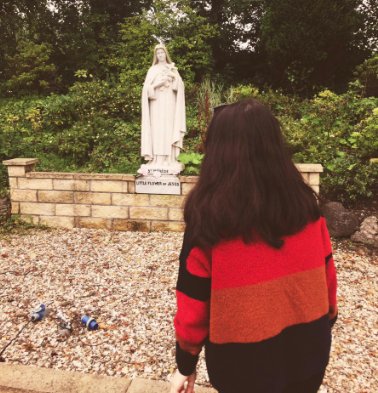September 13 | ![]() 0 COMMENTS
0 COMMENTS ![]() print
print

St Thérèse’s relics’ tour brought my devotion to life
‘Seeing St Thérèse’s relics in person made stark the reality that she was a young woman just like me’, writes Erin Slaven.
Being able to encounter the relics of a saint is not something I ever imagined that I would do—particularly not in my own Diocese of Motherwell. When I found out that the Little Flower was coming to Scotland, I was elated. I have been open and proud of my devotion to St Thérèse but the prospect of being in the presence of her relics was something I still could not really get my head around.
On a bus leaving from St Cadoc’s in Cambuslang, I headed to Holy Mass, where the relics would be present, with my friend Anne-Marie and her family.
Anne-Marie and I contemplated the significance of what we were going to witness, and I confessed that I still could not really grasp what we were about to see. My friend noted that what we were going to encounter was so special because ‘it reminds us that saints were real people, just like us.’ I agreed: “It’s sort of like fantasy becoming reality.”
Nerves
I think this is exactly why I was quite nervous before witnessing the relics. It felt so surreal. Even if your Faith and belief is strong and you feel close to God or a certain saint, they can still feel somewhat distant. Although you might speak with them every day, there is no tangible person there. As Anne-Marie had said, it is so easy for us to forget that the saints were real people like us—people who lived, died and sinned.
It was almost daunting going to encounter the relics and I could not help but feeling emotional while waiting in the queue to venerate them. Looking at the relics made stark the reality that St Thérèse was a young woman just like me. Made of the same skin and bones, the same age—yet she managed to have such a long-standing impact on the world. In St Francis Xavier’s Chapel, Carfin, it was almost impossible not to look at my own life which is at a similar stage as St Thérèse’s when she died and think about how I can be better.
The Little Flower
The Mass itself was so special with the most apt hymns selected for the Little Flower: my friend and I noted a few days later that Friday’s Mass actually felt a bit like the Christmas Eve vigil in our own parish, St Joseph’s! I awaited the homily with great anticipation as it was being professed by Canon John Udris, who is somewhat of an expert on St Thérèse.
I could not believe when he started speaking that his homily was almost exactly the same as the extensive conversation which had taken place on the bus to Carfin between Anne-Marie and me.
Canon Udris said how special it was to have the relics here to make the Little Flower tangible for the people of the diocese and to demonstrate her same mortality and vulnerability as us.
‘Visible Jesus’
The canon also noted that St Thérèse referred to her own sister Pauline as her ‘visible Jesus,’ the one person who embodied the love of Jesus which she so aspired to. It was nice to think that this childlike thought from St Thérèse had come full circle and now, in St Francis Xavier’s, her relics were the visible Jesus for so many of us.
St Thérèse has given me a lot of little signs in my life and she has helped me with my worries and intentions. In times of difficulty, I am almost certain to come across a flower somewhere! I hoped that, on this special occasion, she would be kind enough to let fall another little sign from Heaven.
I am sure that the conversation between Anne-Marie and me was not unique and that other parishioners also reflected on how special it is that St Thérèse has been personified for us in this tour of Scotland.
Similarities
Maybe it was coincidence, but I can’t help but feel the stark similarities between the homily and our conversation prior to Mass was a wee sign from St Thérèse. A wee sign that she appreciates us all realising how normal, little and imperfect she was and for welcoming her as our ‘visible Jesus’ like she did her sister.
Coming into contact with the relics of saints allows us to realise their human lives and bridges the disconnect between we who are living today and the saints who watch over us. Accepting that they lived and died like us resonates and also sets a precedent for our own lives.
The saints did amazing things but were made of the same stock as us. Acknowledging this should spur us on to consider how we can be better Catholics. This does not mean that we have to be perfect but that we should try to enjoy following in their footsteps: their ‘Little Way.’
“I am simply content to find myself always imperfect, and in this I
find my joy.” — St Thérèse










